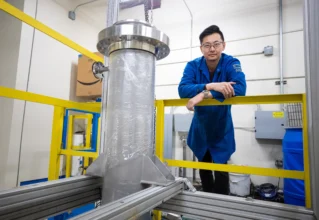Making the leap
Feature Story
How much automation do I need and where is the cost-benefit payout?
By Chris Kastner
The good ol’ mechanical meter register has been a cornerstone of fuel deliveries for decades. Knowing it’s time to replace ol’ reliable with a cutting-edge automated system is a conundrum more and more distributors are confronting.
It’s time for a gut check! There are so many different solutions offered to fuel-delivery providers that it’s hard to tell them apart. Clearly, we are seeing a growing movement toward automation in fuel-delivery systems, but when is automation too much for your business? And what is the cost benefit payout for these systems? Some of this depends on the issues businesses are facing today, whether it is delivery-route optimization, theft, regulatory compliance or accounting.
Whether your business is home-heating fuel, aviation refueling or LPG, you use some kind of meter-registration product to track your deliveries. The ability of any electronic-meter-register system to store fuel-dispensing transaction data is critical in today’s total-solution business environment. If you are currently using a mechanical register you are faced with sticking with your mechanical registers or moving to a more expensive electronic system. There are benefits to both ends of the automation spectrum.
Even though there are some clear advantages to automation, it is not the right answer for every business. It can be expensive and doesn’t always prove beneficial over time. Company owners should consider the pros and cons of the initial costs before automating their businesses. If you have a high business volume that allows you amortize these additional costs over time, it can be worthwhile. If you cannot, then upgrading to an automated system can eat away at your profits with no return. So, let’s look at a brief history of meter registration products and options available to a business owner.
Since the mid-1950s, mechanical registration has dominated the meter-registration industry, with Veeder-Root the dominant manufacturer as a branded and OEM-branded supplier to almost every meter manufacturer, except for Actaris/Neptune, which also has a mechanical solution. This tenure has yielded a literally amazing infrastructure of distribution and service for a very attractive price. Mechanical registers are solid and don’t depend on wiring, ground quality or sophisticated shop mechanics, or line-users. The mechanical register usually yields a simple transaction ticket that can be manually keyed into any system of any level of sophistication. It’s simple.
How reliable and adaptable your drivers are can play a part in whether or not you decide to automate your fuel-delivery system.
This simplicity is a key benefit to having a mechanical register, but also its shortfall. The mechanical solution fundamentally doesn’t have a logic center or brain. Therefore, it can’t store information, or make decisions. If your business requires this, or you aspire to change your operating principles, you need registration with a brain. One size does not fit all.
So, what does an electronic meter register offer? Read a trade publication, or walk a trade show, and the only advertised solution is the electronic register. Why? Larger profits for the manufacturers on electronics, and the recent explosion of companies who build entire businesses around information flow for productivity have emphasized this.
Mechanical registration is still the prominent solution used today and industry experts expect it to continue unless stronger forces than incremental improvement in business productivity turn it elsewhere. There are, however, regulatory dynamics that can prompt a transition to electronics such as the threat of regulated temperature compensation.
Some of the ‘business improvement needs” that drive electronic registration are:
Automatic currency transactions.
Remote control of the fueling point.
Some registers can store transaction information for retrieval.
Electronic registers help prevent product theft and account for delivery activity by providing reports of information.
They have “logic,” which is a foundation for continuous development.
They eliminate the needs for manual activity and record-keeping, and can streamline the delivery-to-invoice process.
What are the dynamics for your business? What is the size? Scope? What are your real costs that can be alleviated by enhanced productivity solutions? It is important to have a very good understanding of where the largest opportunities are in your business. If you buy more ‘solution” than you need you very quickly find yourself upside-down on your investment. Does the sophistication of the solution match the skills of your drivers? Mechanics? Back office support? Make the change to electronic registration to address an opportunity in your business, not because others are doing it, or that it seems to be the trend. Here is a snapshot (page 45) of what the various solutions cost and what the benefits are.
As the charts indicate, enhanced features come at a substantial cost for both product hardware and, more importantly, the sophisticated support you will be required to have in place to benefit from this type of solution.
Automation is a great opportunity to improve the way you do business. If you understand your business’ priorities, and how well your support network will adopt and support the new technology, you can match up your investment in the right bucket.
Some final tips:
Don’t write off the Good Ol’ Mechanical.
Don’t buy more complexity than you need for your business, but if you need it, make the leap.
Plan to sell the “cultural change” in your business to your employees.
Be aware of the total project cost and management commitment.Chris Kastner is the vice president of operations and general manager of petroleum products for Veeder-Root. He can be reached at (814) 696-8120.

